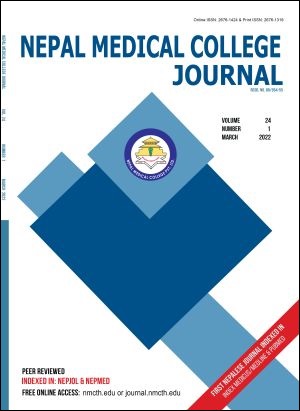Maternal short stature, household socio-economic status and stunting among under-two children attending an immunization clinic at a tertiary hospital in Kathmandu, Nepal
DOI:
https://doi.org/10.3126/nmcj.v24i1.44102Keywords:
Maternal stature, socio-economic status, child health, stunting, NepalAbstract
Stunting or poor linear growth affects about 25% of children under five globally. Poor linear growth may occur due to lack of nutrients or due to hormonal influences. This study has investigated the relationship between maternal stature, household socio-economic status and linear growth among children below two years of age visiting the immunization clinic at an urban tertiary hospital in Kathmandu, Nepal. An observational cross-sectional analytical study was carried out through a face-to-face interview of mothers with a pretested standardized proforma. Anthropometric measurement of mother and child dyads was carried out to assess the nutritional status. Nutritional anthropometry tool in Epi-Info version 7.2.0.2 was used to calculate height-for-age z-scores (HAZ) based on the WHO 2007 reference data. A cut-off of –2 z-scores was used to define stunting (<-2HAZ). Linear regression was used to study the correlation between maternal anthropometric indices and HAZ scores. Univariate logistic regression was used to assess potential predictors. Among 396 mother-child dyads, with 186 female children, the prevalence of low birth weight was 7% (95% CL: 5.1% to 10.3%) and stunting was 4.5% (95% CL: 2.9 to 7.0). Proportion of mothers with short stature (<145 cm) was 7.5% (95% CL: 5.3% to 10.5%). Maternal height had a higher correlation with HAZ in comparison to weight (r 0.24, P<0.0001 vs 0.09, P=0.04). The mean HAZ score among infants (<6 months) was 1.25, 0.22 among those aged 6-11 months and -0.15 among those 12 months and above. Preterm birth (P=0.03), low birthweight (P<0.001) and being underweight (P=0.001) were associated with stunting. Though a low prevalence of stunting was seen, the downward shift in HAZ indicated a deficit in linear growth at the population level. This reflected the utility of HAZ as a population level marker for child undernutrition. As the prevalence of stunting among under-five children has continued to decline in Nepal, eliminating the downward shift in linear growth among under-two children can be prioritized. Potential areas of research include identification of appropriate cut-offs for maternal short stature and exploration of the epidemiological association between ponderal and linear growth among children in the local context. A consistent access to care during the antenatal period, child delivery and improved child feeding practices may have helped to improve the nutritional status among the under-two children. Assessment of linear growth along with weight gain needs to be emphasized during growth monitoring.
Downloads
Downloads
Published
How to Cite
Issue
Section
License
Copyright (c) 2022 Nepal Medical College Journal

This work is licensed under a Creative Commons Attribution 4.0 International License.
This license enables reusers to distribute, remix, adapt, and build upon the material in any medium or format, so long as attribution is given to the creator. The license allows for commercial use.




